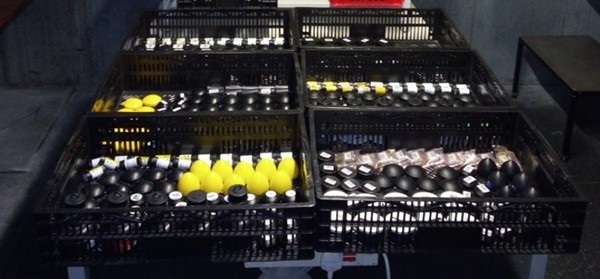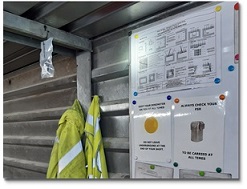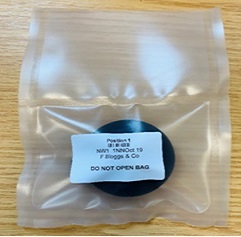Radon laboratory services for professionals
Radon address search
A report will tell you the estimated probability above the Action Level.
Order a reportRadon measurement pack
Find out the yearly average radon level for a property and if it is above or below the Action Level.
Order a domestic pack Order a workplace packDo you need to obtain radon measurements from an unusual location, such as a cave with high humidity? Do you want to be sure that your electronic radon monitor is reading correctly? Are you a mitigation contractor or looking for specialist radon technical services? Find all this information and more here.
Calibration services
Radon detectors must be calibrated in order to respond correctly. Passive detectors are calibrated before being issued. Electronic radon detectors must be calibrated before first use and annually thereafter if they are being used for compliance with the Ionising Radiations Regulations 2017.
Read More
Whether it is passive detectors, active instruments or one of the many Electronic Radon Integrated Monitors (ERIMs) introduced in recent years, these must all be calibrated to ensure that the radon monitor is giving an accurate and reliable reading.
Manufacturers of passive radon detectors can submit sample etched track detectors for known exposures to ensure that the detector elements are of the correct sensitivity and that their track reading system is functioning correctly.
For instruments being used to measure radon levels in workplaces, the Ionising Radiations Regulations 2017 apply. These regulations state that instruments must be calibrated before use and then annually.
We strongly recommend annual calibrations for any instrument being used to monitor radon.
For all enquiries, and to book a calibration, please email: Radon.Calibration@ukhsa.gov.uk We will provide you with a quotation, estimated turnaround time and potential date for commencement of the work.
Below is a non-exhaustive list of some of the calibration services we currently provide. If you don't see your instrument, detector or device, please don't hesitate to contact us by the link above.
Please do not send instruments or detectors for calibration until after you have contacted us and we have agreed a start date for the work.
For more information on the radon chamber or the Fast Radon Exposure Device (FRED), and the hiring of either, please see "Hire of Radon Chamber" section below.
Passive DetectorsExposures in the Radon Chamber
- Batch of passive detectors exposed together, F not monitored*:
- Up to 2000 etched track
- Or up to 50 charcoal
- Or up to 100 electret
- (*Note that we can accept more than one batch to be exposed at the same time.)
- One week calibration of up to 2000 etched track monitors, F monitored
- Longer exposures are available on a daily rate, F monitored
- (*Note that we can accept more than one batch to be exposed at the same time.)
Active Instruments
- Pylon or RDA plus 1 flow through cell or up to 5 passive cells or scintillation trays (additional trays or passive cells incur an additional charge)
- Alphaguard monitor
- Integrating Working Level Monitor (IWLM)
- Rad 7 monitor
- ERIMs:
- AER+ (Algade)
- Alpha E (Bertin instruments)
- Canary (now rebranded as the Corentium Home) (Airthings)
- Corentium Pro (Airthings)
- Sun Nuclear (Sunradon LLC)
- Radon Eye (Radon FTLab)
- Radon Scout (SARAD)
- Ramon (GTAnalytic SARL)
- Wave (Airthings)
For other services we provide besides calibrations, such as validation schemes, intercomparisons, and natural gas testing, please see the relevant sections below.
For all enquiries, and to book a calibration, please email: Radon.Calibration@ukhsa.gov.uk We will provide you with a quotation, estimated turnaround time and potential date for commencement of the work.International intercomparison of passive monitors
Our annual intercomparison is where sets of detectors from multiple laboratories are given simultaneously a range of radon exposures (unknown to them) and the objective is to determine those exposures with high accuracy and precision.
Read More
The passive detectors used for this purpose can be in the form of etched track detectors (PADC/CR-39, LR115, Microfol, etc), electret radon detectors, or activated charcoal detectors. There are limitations with some of the designs, but most can be accommodated.
How radon laboratories can participate
Each year at the UKHSA Radiation, Chemical, Climate and Environmental Hazards Directorate (RCCE) laboratories in Oxfordshire, we carry out an international intercomparison of passive detectors for radon laboratories from around the world. The instruments in our 43 m³ Radon Chamber are calibrated to traceable standards using a source from an accredited laboratory. This means that we can provide reference exposures.
The detectors will be randomised into 6 groups: 5 groups will be exposed to different exposure levels in the range 100 - 2,400 kBq m-3 detectors from the 6th group are not exposed and record the exposures in transit.
There is a charge for each set of detectors submitted. A detailed report of the detector performance is supplied to the customer.
Following the annual intercomparison, an anonymised report of the findings from the participating laboratories is published here
If you wish to take part in the next intercomparison, or require further information, please email: Radon.Calibration@ukhsa.gov.uk.

Many different types of radon detectors in trays being exposed in the Radon Chamber
Hire of Radon Chamber
The 43 m3, walk-in Radon Chamber is available for hire by customers to test equipment themselves, if necessary. Radon Group scientists will be available to adjust conditions within the chamber to the customer's requirements (normally from 400 Bq m-3 to 8,000 Bq m-3). A small facility is also available with a radon concentration of around 80,000 Bq m-3.
Read More
The radon group at UKHSA and predecessor organisations has operated radon exposure facilities for over forty years, for research and the calibration of passive detectors and radon monitoring instruments. These facilities allow for exposures to known levels of radon gas that are measured using instruments which have been calibrated to traceable standards using a source from an accredited laboratory.
If you are interested in hiring either of our facilities listed below, please email: Radon.Calibration@ukhsa.gov.uk.
The main exposure facility is a 43 m³ walk-in radon chamber that is accessed by an airlock. Radon gas is maintained at a sufficiently high level in the chamber to allow exposures to be completed in a relatively short time. For example, a set of passive detectors can be exposed to the equivalent of three months at the current UK Action Level of 200 Bq m-3 in a matter of days - while still allowing staff to safely enter the chamber.
UKHSA Radon Chamber details
Radon concentration: 400-8,000 Bq m-3
Volume: 43 m3
Monitored continuously: radon gas, temperature, humidity, barometric pressure
Additional variables available for monitoring: decay products, working level, equilibrium factor, ambient aerosol
Controllable parameters: radon gas concentration, equilibrium factor (F), aerosol concentration
Uncertainties (95% Confidence Limit): radon gas 10%, decay products, working level, equilibrium factor 20%
The chamber is suitable for a wide variety of radon detectors and instruments. It has also been used to test other types of equipment - such as determining the radon response of actinide in air contamination monitors and etched-track neutron dosemeters.
Usually, clients send their instruments or passive detectors to us for our staff to undertake the exposures. It is also possible for clients to carry out their own radon experiments by hiring the chamber on a daily basis. Monitoring, controlling and reporting the conditions in the radon chamber listed above throughout this time can be provided.
Another facility that is available is the Fast Radon Exposure Device (also known as FRED). This facility has a much higher radon concentration compared to the radon chamber. This allows for either exposures in an even shorter amount of time or much higher exposures, which can be useful when determining a detector's linearity of response.
However, this facility is much smaller than the radon chamber, and so can only be used for a small number of detectors. It is too small for some active instruments, and any instruments placed inside would need their own inbuilt power source.
Fast Radon Exposure Device (FRED) details
Radon concentration: 40-70 kBq m-3
Volume: 0.2 m³
Monitored continuously: radon gas
Uncertainties (95% CL): radon gas 20%
Electronic radon integrating monitors (ERIMs)
ERIMs are electronic radon monitors that aim to determine accurately the long-term average radon concentrations. Following studies of ERIMs, we recommend certain helpful techniques. In addition, the detectors must be calibrated if they are to be used for regulatory compliance.
Read More
These detectors have gained popularity due to their relatively low cost and ease of use.
However, the visible display of a radon concentration on many of the ERIMs leaves them open to misuse. Note that there is no such thing as an 'instant' radon reading as the physics of radioactive decay requires sufficient time for any instrument to respond, i.e. several days.
UKHSA studied the performance of some of these monitors recently and recommend the following:
- Instruments should be cleared of previous records and reset according to instructions. This often requires an extra step in addition to switching the instrument off and on again
- Before starting a measurement, the batteries should be replaced with new ones and/or the instruments should be fully charged
- ERIM instruments require annual calibration if used for workplace measurements (when regulatory compliance is needed, e.g. the Ionising Radiations Regulations 2017)
- Instruments should be left undisturbed for at least few days before the data is downloaded or used (their low sensitivity means that they cannot respond quickly to a new location)
If ERIM instruments are intended for a long-term study of indoor radon, then they should follow the same instructions of placement as passive detectors
Radon passive monitor services - harsh environments
Passive monitors can be used in unusual situations, provided that special provisions are made to ensure that they are protected from very high humidity, radioactive contamination and other harsh environments. These services are also suitable for measurements in mines, caves, tunnels, water treatment works, outdoors, and in gamma radiation and neutron fields.
Read More
As these environments are different from most other workplaces, please note the multiple changes that are made to the monitoring protocol in terms of:
- 1. Placement
- 2. Duration
- 3. Seasonal corrections
- 4. Humidity
- 5. Contamination
- 6. Neutron radiation fields
- 7. Other considerations
The detectors need to be placed in locations that reflect the main working areas:
Mines - identify points in the main working areas and travel roads, taking the ventilation circuit into account along with cross-cuts and multiple levels. Old workings should be monitored if they are inspected for roof, etc, but no special access should be made for radon monitoring alone. There is no 'correct' number of detectors according to length of roadway or area/volume, although linking radon monitoring positions with those used for air flow measurements is helpful. The detectors should hang from cables or other fixtures at around head height; do not push them into crevices as this can adversely affect the results.
Caves should be monitored in a similar way to mines. You may need to take pegs or similar items to fix the monitoring positions. If there are multiple entrances and exits to the cave system, detectors placed in these areas will indicate the average air flow.
Tunnels - ensure that a detector is placed securely at each end and at multiple points in between. If the tunnel is simple, few intermediate monitoring positions are required. Include side passages and refuges.
Water treatment works can be monitored as for most ordinary buildings, ensuring that all main areas are represented.
Areas with radioactive contamination can be monitored as for an ordinary building.
For detectors being placed in the above environments please email: Radon@ukhsa.gov.uk.
Areas with neutron radiation have two detectors placed at each location: one detector is standard; the second detector remains in a radon-proof bag.

A radon detector in a water-resistant bag hanging from the roof of a mine tunnel
Duration
Radon detectors placed in harsh environments can have their exposure time reduced to one month. This is to reduce the chances of the detectors being damaged and because the seasonal variations in radon levels will not be typical. Mines and caves can have extreme variations between summer and winter, with the summer showing the highest radon levels (in contrast to most ordinary buildings).
Seasonal correctionsAs these are not typical buildings, we cannot estimate the annual average radon concentration from the typical seasonal variations. We recommend that you anticipate two monitoring periods in opposite seasons to obtain a pair of results for each location, which can be averaged to obtain a value that can be compared to the Ionising Radiations Regulations 2017 threshold of 300 Bq m-3.
HumidityHigh relative humidity can prevent a result being obtainable as condensation forming inside the radon detectors forms a protective film over the detecting element. To prevent this, radon detectors can be issued in water-resistant/radon-permeable bags [references 1,2,3]. These must be requested at the time of ordering and the detectors must not be removed from the bags, otherwise the results will be invalid.


Contamination (e.g. radioactive)
Radon detectors can be placed in areas with loose radioactive contamination, using the water-resistant/radon-permeable bags. The detector must stay in the bag during exposure. The outside of the bag must be checked by Health Physics/RPS/RSO before being returned for processing. If contamination is found that cannot be removed, then the detector can be taken from the bag and checked further, then returned for processing if clear. This must be clearly marked on the record sheet.
A clearance certificate from Health Physics should be returned with the detectors.
Gamma radiation Gamma radiation cannot be detected by radon detectors. However, high gamma fields can cause structural damage to the CR-39 element, which makes it unable to record radon exposure properly. The background gamma radiation is usually too low to cause such damage [2]. If radon levels are to be measured in the presence of high gamma fields, please email: Radon.Calibration@ukhsa.gov.uk for advice.
UV / sunlight The radon detector's sensing element is very sensitive to sunlight and UV radiation. It is normally well protected from exposure by the outer casing, however, placing the detector directly in sunlight should be avoided to eliminate infrared (thermal) radiation that can greatly influence its ability to detect radon correctly [2,3,4].
Please email: Radon.Calibration@ukhsa.gov.uk if you would like to test in any of the above environments.
References